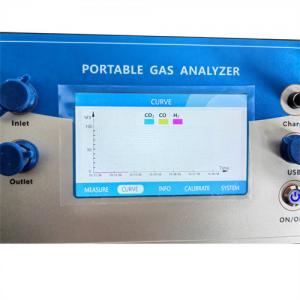
Add to Cart
Process gas analyser Industrial Process Gas Analyzers NDIR sensor O2 CH4 CO methane gas analyser Hydrogen gas analyser
Process gas analyzers are specialized instruments used to continuously monitor and analyze the composition and characteristics of gases in industrial processes. They play a crucial role in process control, optimization, safety, and regulatory compliance in various industries such as oil and gas, petrochemical, power generation, chemical, and pharmaceutical.
Process gas analyzers are designed to be integrated directly into the process stream and provide real-time measurements of gas concentrations, temperature, pressure, and other relevant parameters. They help ensure that the process operates within specified limits and that the quality of the end product meets the required standards.
Here are some key features and components commonly found in process gas analyzers:
1. Gas Sampling System: Process gas analyzers are equipped with a sampling system that extracts representative gas samples from the process stream. The sampling system typically includes probes, filters, and conditioning equipment to remove impurities, adjust temperature and pressure, and prepare the sample for analysis.
2. Gas Detection Technology: Process gas analyzers employ various gas detection technologies depending on the types of gases being measured. Some common techniques include:
- Infrared (IR) Absorption: IR analyzers use the absorption characteristics of gases in the infrared region to measure concentrations of gases such as carbon dioxide (CO2), carbon monoxide (CO), hydrocarbons, and other specific compounds.
- Electrochemical Sensors: These sensors use chemical reactions to detect and measure specific gases, such as oxygen (O2), hydrogen sulfide (H2S), and toxic gases. They are compact, cost-effective, and offer fast response times.
- Paramagnetic or Thermal Conductivity: These techniques are used to measure the concentration of gases such as oxygen (O2) or nitrogen (N2) in the process stream.
- Flame Ionization Detection (FID): FID analyzers are specifically designed for the measurement of hydrocarbon concentrations. They use a hydrogen flame and detect the ionization of hydrocarbon molecules.
- Catalytic Bead or Pellistor: These sensors are used to detect and measure the concentration of flammable gases, such as methane (CH4) or propane (C3H8). They operate based on the catalytic oxidation of the gas molecules.
3. Data Analysis and Display: Process gas analyzers provide real-time measurement data that is typically displayed on a local control panel or integrated into the plant's control system. The analyzers may include a digital display or graphical user interface (GUI) to show gas concentrations, trends, alarms, and other relevant information.
4. Communication and Connectivity: Process gas analyzers often feature communication interfaces such as analog outputs (4-20 mA), digital protocols (Modbus, Profibus, Ethernet), or wireless connectivity options. This allows for integration with distributed control systems (DCS), programmable logic controllers (PLCs), or other networked systems.
5. Calibration and Maintenance: Process gas analyzers require regular calibration and maintenance to ensure accurate and reliable measurements. The calibration process involves verifying the accuracy of the sensors and adjusting them if necessary. Some analyzers offer automatic calibration routines or self-diagnostic capabilities to simplify the calibration process.
It's important to select a process gas analyzer that is suitable for the specific application and meets the required measurement range, accuracy, and regulatory standards. Consulting with manufacturers or experts in the field can help in choosing the right analyzer for a particular industrial process.
Process gas analyzer is an important tool in process safety and quality control. It helps to monitor and optimize the chemical composition of process gases. The gas analyzer market is segmented by type, technology, application, and geography.
Our gas analyzers high-stability infrared detector and TDL technology for the simultaneous measurement of CO, CO2, and CH4. These gases are suitable for challenging applications such as syngas and gasification atmospheres. In addition, analyzers may use a compensated thermal conductivity cell for H2. Electrochemical O2 sensors may also measure percent levels of oxygen in the sample gas stream.
| INFRARED NDIR DETECTOR | |||||
| GAS | Lowest Range | Highest Range | LR resolution | HR resolution | Accuracy FS |
| CO | 0-5% | 0-100% | 0,001 % | 0,01 % | ≤ ±2% |
| CO2 | 0-5% | 0-100% | 0,001 % | 0,01 % | ≤ ±2% |
| CH4 | 0-5% | 0-100% | 0,001 % | 0,01 % | ≤ ±2% |
| CnHm | 0-10% | 0,001 % | 0,01 % | ≤ ±2% | |
| THERMAL CONDUCTIVITY DETECTOR (TCD) | |||||
| H2 | 0-20% | 0-100% | 0,01% | 0,01% | ≤ ±3% |
| ELECTROCHEMICAL DETECTOR (ECD) | |||||
| O2 | 0-25% | 0,01 % | 0,01 % | ≤ ±3% | |